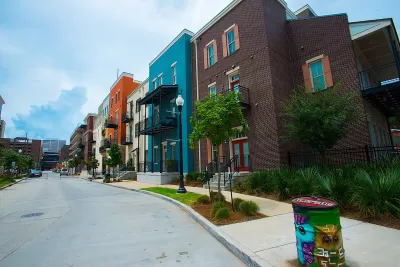For such a commonly used term, “affordable housing” means a lot of different things to different people and in different contexts.For such a commonly used term, “affordable housing” means a lot of different things to different people and in different contexts.

The term "affordable housing" gets tossed around frequently in policy discussions and development debates, but its meaning is far from simple. A new Shelterforce explainer breaks down this complex term, offering crucial context for planners, policymakers, and community development practitioners.
At its most basic, housing affordability hinges on a simple concept: after paying for housing, do residents have enough left for other basic needs? While this sounds straightforward, measuring it proves complex. The industry standard — the 30 percent rule — suggests housing costs should consume no more than 30 percent of household income. Yet this benchmark, while useful for middle-income households, breaks down at both extremes of the income spectrum.
The complexity deepens when examining specific affordable housing initiatives. Projects labeled as "affordable" can target vastly different income levels and populations, from extremely low-income supportive housing to moderate-income workforce developments. Programs like the Low Income Housing Tax Credit typically serve households making 40 to 60 percent of area median income, while Section 8 vouchers reach even lower-income residents. Meanwhile, what counts as affordable in high-cost coastal cities might align with market rates in other regions.
Understanding these nuances is crucial for planners, policymakers, and advocates working to address the housing crisis. Effective housing policy requires moving beyond simple labels to examine who exactly is being served, how affordability is achieved, and how long it will last.
FULL STORY: What Is ‘Affordable Housing’?

Study: Maui’s Plan to Convert Vacation Rentals to Long-Term Housing Could Cause Nearly $1 Billion Economic Loss
The plan would reduce visitor accommodation by 25,% resulting in 1,900 jobs lost.

North Texas Transit Leaders Tout Benefits of TOD for Growing Region
At a summit focused on transit-oriented development, policymakers discussed how North Texas’ expanded light rail system can serve as a tool for economic growth.

Why Should We Subsidize Public Transportation?
Many public transit agencies face financial stress due to rising costs, declining fare revenue, and declining subsidies. Transit advocates must provide a strong business case for increasing public transit funding.

How to Make US Trains Faster
Changes to boarding platforms and a switch to electric trains could improve U.S. passenger rail service without the added cost of high-speed rail.

Columbia’s Revitalized ‘Loop’ Is a Hub for Local Entrepreneurs
A focus on small businesses is helping a commercial corridor in Columbia, Missouri thrive.

Invasive Insect Threatens Minnesota’s Ash Forests
The Emerald Ash Borer is a rapidly spreading invasive pest threatening Minnesota’s ash trees, and homeowners are encouraged to plant diverse replacement species, avoid moving ash firewood, and monitor for signs of infestation.
Urban Design for Planners 1: Software Tools
This six-course series explores essential urban design concepts using open source software and equips planners with the tools they need to participate fully in the urban design process.
Planning for Universal Design
Learn the tools for implementing Universal Design in planning regulations.
Ascent Environmental
Borough of Carlisle
Institute for Housing and Urban Development Studies (IHS)
City of Grandview
Harvard GSD Executive Education
Toledo-Lucas County Plan Commissions
Salt Lake City
NYU Wagner Graduate School of Public Service





























